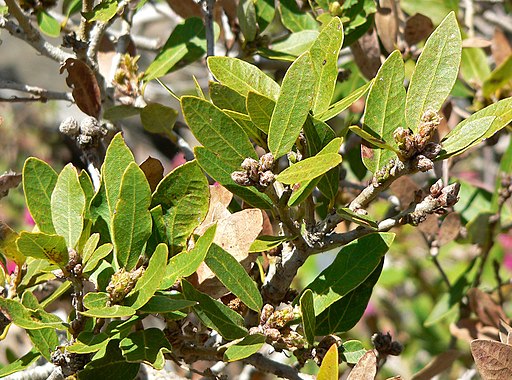Classification System: APG IV
Superregnum: Eukaryota
Regnum: Plantae
Cladus: Angiosperms
Cladus: Eudicots
Cladus: Core eudicots
Cladus: Rosids
Cladus: Eurosids I
Ordo: Fagales
Familia: Fagaceae
Genus: Quercus
Species: Quercus vacciniifolia
Name
Quercus vacciniifolia Hittell, 1863
Synonyms
Homotypic
Quercus chrysolepis subsp. vacciniifolia (Hittell) Engelm., Trans. Acad. Sci. St. Louis 3: 393 (1877).
Quercus chrysolepis var. vacciniifolia (Hittell) Engelm. in S.Watson, Bot. California 2: 97 (1879).
Distribution
Native distribution areas:
Continental: Northern America
Regional: Southwestern USA
California, Nevada, Oregon
References: Brummitt, R.K. 2001. TDWG – World Geographical Scheme for Recording Plant Distributions, 2nd Edition
References
Primary references
Hittell, J.S., 1863. Resources California: 101
Additional references
Govaerts, R.H.A. & Frodin, D. 1998. World Checklist and Bibliography of Fagales (Betulaceae, Corylaceae, Fagaceae and Ticodendraceae). VIII + 408 p. The Board of Trustees of the Royal Botanic Gardens, Kew. ISBN 1-900347-46-6. Reference page.
Links
Govaerts, R. et al. 2021. Quercus vacciniifolia in World Checklist of Selected Plant Families. The Board of Trustees of the Royal Botanic Gardens, Kew. Published on the internet. Accessed: 2021 Jul 04. Reference page.
Govaerts, R. et al. 2021. Quercus vacciniifolia in Kew Science Plants of the World online. The Board of Trustees of the Royal Botanic Gardens, Kew. Published on the internet. Accessed: 2021 Jul 04. Reference page.
International Plant Names Index. 2021. Quercus vacciniifolia. Published online. Accessed: Jul 04 2021.
Tropicos.org 2021. Quercus vacciniifolia. Missouri Botanical Garden. Published on the internet. Accessed: 2021 Jul 04.
Hassler, M. 2021. Quercus vacciniifolia. World Plants: Synonymic Checklists of the Vascular Plants of the World In: Roskovh, Y., Abucay, L., Orrell, T., Nicolson, D., Bailly, N., Kirk, P., Bourgoin, T., DeWalt, R.E., Decock, W., De Wever, A., Nieukerken, E. van, Zarucchi, J. & Penev, L., eds. 2021. Species 2000 & ITIS Catalogue of Life. Published on the internet. Accessed: 2021 Jul 04. Reference page.
Hassler, M. 2021. World Plants. Synonymic Checklist and Distribution of the World Flora. . Quercus vacciniifolia. Accessed: 04 Jul 2021.
USDA, ARS, Germplasm Resources Information Network. Quercus vacciniifolia in the Germplasm Resources Information Network (GRIN), U.S. Department of Agriculture Agricultural Research Service. Accessed: 07-Oct-06.
Vernacular names
English: Huckleberry Oak
Quercus vacciniifolia (sometimes spelled Q. vaccinifolia), the huckleberry oak, is a member of the Protobalanus section of genus Quercus. It has evergreen foliage, short styles, very bitter acorns that mature in 18 months, and a woolly acorn shell interior.
Description
Quercus vacciniifolia is a shrubby evergreen of the oak family, which grows generally less than 1.5 m (5 feet) tall and spreads horizontally, never becoming a tree. In the field, it is best identified from its clustered terminal buds, which is characteristic of all plants of the genus. Species are more easily identified in the presence of acorns. Acorns of Q. vacciniifolia mature in 2 years (biennial maturation) after pollination. Flowers and inflorescence characteristics are not used to significant extend in this genera. Quercus vacciniifolia can be easily confused with Quercus cedrosensis, which grows in dry chaparrals, such as California-Mexico border south, forests of Baja California and at higher elevations on Cedros Island.[3] Morphologically, the two species differ in their leaf margins: while Q. vacciniifolia leaves are entire to mucro-toothed, Q. cedrosensis leaves are entire or have irregular spine-tipped teeth.[3][4]
Distribution
Quercus vacciniifolia is native to the western United States, where it can be found in the Sierra Nevada of California, where its distribution extends just into Nevada, and the Klamath Mountains and southern Cascade Range as far north as southern Oregon. It grows in high mountain forests. It also dominates sections of mountain chaparral.[5][6][7]
Habitat
Quercus vacciniifolia can be found in steep slopes, ridges, conifer forests, and sub-alpine forest, mostly in high montane area at altitudes of 150 to 2930 m.[8] It is native of California, but can also be found in Oregon and Nevada. Hybridization between Q. vacciniifolia and Q. chrysolepis has been extensively reported in Sierra Nevada.[3] Between the early and middle Holocene, 11000 and 5000 cal years BP, Q. vacciniifolia were an extensive shrub in the Klamath Mountains (at the northern portions of California), which had ultramafic soils. At this period, Q. vacciniifolia was a main fire developer due to its abundance, mid-height and resinous leaves. Today, Q. vacciniifolia rarely forms dense chaparral-like stands, allowing fire resistant species to grow intermittently.[9]
Uses
Many animal species use this shrub for food, including mule deer, which eat the leaves, and many birds and mammals, including the American black bear, which eat the acorns.[5]
The Quercus vacciniifolia plant is used in restoration, revegetation, and garden landscaping. It is good for preventing erosion, such as on the slopes above Lake Tahoe to slow the erosion that pollutes the lake.[5]
References
Wikimedia Commons has media related to Quercus vacciniifolia.
"Quercus vacciniifolia Kellogg". World Checklist of Selected Plant Families (WCSP). Royal Botanic Gardens, Kew – via The Plant List.
"Quercus vaccinifolia Kellogg". Tropicos. Missouri Botanical Garden.
Kevin C. Nixon (2002) The Oak (Quercus) Biodiversity of California and Adjacent Regions, USDA Forest Service Gen. Tech. Rep. PSW-GTR-184.
Nixon, Kevin C. (1997). "Quercus vaccinifolia". In Flora of North America Editorial Committee (ed.). Flora of North America North of Mexico (FNA). Vol. 3. New York and Oxford – via eFloras.org, Missouri Botanical Garden, St. Louis, MO & Harvard University Herbaria, Cambridge, MA.
Howard, Janet L. (1992). "Quercus vacciniifolia". Fire Effects Information System (FEIS). US Department of Agriculture (USDA), Forest Service (USFS), Rocky Mountain Research Station, Fire Sciences Laboratory.
"Quercus vacciniifolia". County-level distribution map from the North American Plant Atlas (NAPA). Biota of North America Program (BONAP). 2014.
"Quercus vacciniifolia". Calflora. Berkeley, California: The Calflora Database.
Rosatti, Thomas J.; Tucker, John M. (2014). "Quercus vacciniifolia". In Jepson Flora Project (ed.). Jepson eFlora. The Jepson Herbarium, University of California, Berkeley.
R. Scott Anderson. Holocene Forest Development and Paleoclimates within the Central Sierra Nevada, California. (1990) Journal of Ecology (1990), 78. p470-489.
Retrieved from "http://en.wikipedia.org/"
All text is available under the terms of the GNU Free Documentation License


